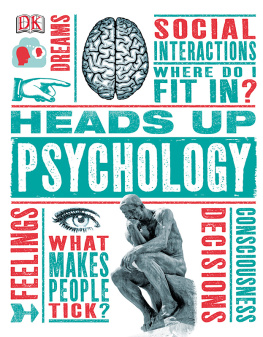The right of Meg-John Barker to be identified as author of this work has been asserted by them in accordance with sections 77 and 78 of the Copyright, Designs and Patents Act 1988.
All rights reserved. No part of this book may be reprinted or reproduced or utilised in any form or by any electronic, mechanical, or other means, now known or hereafter invented, including photocopying and recording, or in any information storage or retrieval system, without permission in writing from the publishers.
Names: Barker, Meg-John, 1974author.
Title: The psychology of sex/Meg-John Barker.
Description: New York : Routledge, 2018. | Includes index.
Subjects: LCSH: Sex (Psychology) | Sex.
The Psychology of Everything
The Psychology of Everything is a series of books which debunk the myths and pseudo-science surrounding some of lifes biggest questions.
The series explores the hidden psychological factors that drive us, from our sub-conscious desires and aversions, to the innate social instincts handed to us across the generations. Accessible, informative, and always intriguing, each book is written by an expert in the field, examining how research-based knowledge compares with popular wisdom, and illustrating the potential of psychology to enrich our understanding of humanity and modern life.
Applying a psychological lens to an array of topics and contemporary concerns from sex to addiction to conspiracy theories The Psychology of Everything will make you look at everything in a new way.
Titles in the series:
The Psychology of Grief
Richard Gross
The Psychology of Sex
Meg-John Barker
The Psychology of Dieting
Jane Ogden
The Psychology of Performance
Stewart T. Cotterill
The Psychology of Trust
Ken J. Rotenberg
The Psychology of Working Life
Toon Taris
The Psychology of Conspiracy Theories
Jan-Willem van Prooijen
The Psychology of Addiction
Jenny Svanberg
The Psychology of Fashion
Carolyn Mair
The Psychology of Gardening
Harriet Gross
The Psychology of Gender
Gary W. Wood
For further information about this series please visit www.thepsychologyofeverything.co.uk
Contents
Guide
Chapter 1
When Im talking about psychology in this book Im generally referring to western psychology within a western cultural context. Theres a lot of scope in this area for engaging with psychologies that have developed in other cultural contexts, as well as with the vast cultural diversity that exists in understandings of sex and sexuality. However, sadly this is something that hasnt happened much in the psychology of sex to date, so I wont cover it in depth in this book. The further reading at the end will give you some pointers if youre interested in exploring this more.
Rosenhan, D. L. (1973). On being sane in insane places. Science , , 250258. An updated version of this study is reported in Slater, L. (2004). Opening Skinners box: Great psychological experiments of the twentieth century . London: W. W. Norton.
Gould, S. J. (1996). The mismeasure of man . London: W. W. Norton & Company.
Tavris, C. (1991). The mismeasure of woman: Paradoxes and perspectives in the study of gender . Washington, DC: American Psychological Association.
Sistrunk, F., & McDavid, J. W. (1971). Sex variable in conforming behaviour. Journal of Personality and Social Psychology , , 200207.
You might like to compare, for example, the contents pages of Justin Lehmillers The psychology of human sexuality (Oxford: Blackwell, 2014), Chess Denmans Sexuality: A biopsychosocial approach (London: Palgrave, 2003), and Christina Richards and my own Palgrave handbook of the psychology of sexuality and gender (Palgrave: London, 2003), all of which are included as further reading in this book. Youd see even more variation if you looked back over the contents pages of psychology of sexuality textbooks over the last century. This is something that Christina and I write more about in this paper: Barker, M., & Richards, C. (2013). What does Bancrofts Human sexuality and its problems tell us about current understandings of sexuality? Feminism & Psychology , (2), 243251.
Spiderman (timeless).
Chapter 2
for some childrens books which are trying to be more inclusive.
Swearer, S. M., Turner, R. K., Givens, J. E., & Pollack, W. S. (2008). Youre so gay!: Do different forms of bullying matter for adolescent males? School Psychology Review , (2), 160.
Although well come back to some more recent versions of psychoanalysis and what we might usefully learn from them in Chapter 5.
Barker, M. (2007). Heteronormativity and the exclusion of bisexuality in psychology. In V. Clarke & E. Peel (Eds.), Out in psychology: Lesbian, gay, bisexual, trans, and queer perspectives (pp. 86118). Chichester, UK: Wiley.
Carey, B. (2005). Straight, gay or lying: Bisexuality revisited. New York Times , 5.
Rieger, G., Chivers, M. L., & Bailey, J. M. (2005). Sexual arousal patterns of bisexual men. Psychological Science , (8), 579584.
Rosenthal, A. M., Sylva, D., Safron, A., & Bailey, J. M. (2011). Sexual arousal patterns of bisexual men revisited. Biological Psychology , (1), 112115.
For a review of the research on bisexuality see Barker, M., Richards, C., Jones, R., Bowes-Catton, H., & Plowman, T. (2012). The bisexuality report: Bisexual inclusion in LGBT equality and diversity. Milton Keynes: The Open University, Centre for Citizenship, Identity and Governance.
Kinsey, A. C., Pomeroy, W. B., & Martin, C. E. (1948). Sexual behavior in the human male. Bloomington: Indiana University Press; Kinsey, A. C., Pomeroy, W. B., & Martin, C. E. (1953). Sexual behavior in the human female. Bloomington: Indiana University Press.
The film Kinsey is a great starting place if youre interested in finding out more about Kinseys life and work. For details on the research findings see www.kinseyinstitute.org/research/ak-data.html
Klein, F., Sepekoff, B., & Wolf, T. J. (1985). Sexual orientation: A multi-variable dynamic process. Journal of Homosexuality , (12), 3549.
Klein, F. (2014). The bisexual option . New York: Routledge.
Diamond, L. M. (2009). Sexual fluidity. Cambridge, MA: Harvard University Press.












